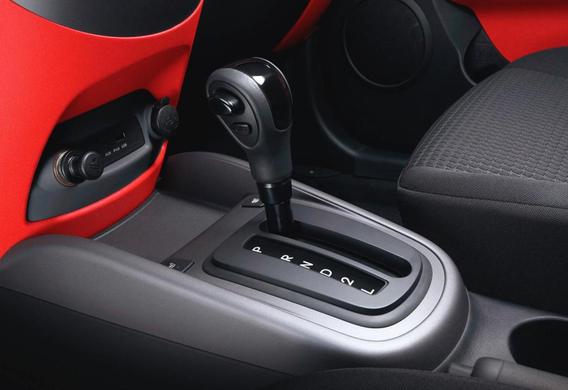
The main difference between the ILC lever and the ECP regime selector is that it is necessary to manually switch the transfer of ICPC, and to do so at all times. Although the ACPR selector is external to the lever, in fact it is a switch that allows the driver to select the range of work of the box, and to change the gear ratios within the selected mode will be electronics. History of the development of the ACPR and the evolution of the selector
History of the development of the ACPR and the evolution of the selector
The first automobiles with a full automatic transmission appeared in 1940 with General Motors and Cadillac. The vehicles were equipped with a three-stage automatic gearbox with a hydraulic transmission control system. This concept has remained unchanged over the next 40 years. The selection of the ACPR work range in American vehicles has always been set at the steering column.
The following symbols were available on the selector of the ACPT of the Soviet bus Laz 677: PP, A, H, ZH. AP-imperative first transfer for start on icy astholate on all-season wheels
At the beginning of the 1980s, the development of ACPR took two main directions. The first is the increase in the number of gears. In 2001, BMW started to install six-speed gearboxes. The second direction is the advent of the electronic box control unit. Originally, the task of the electronic systems was to define only the gear change point. Then there were systems that allowed for the analysis of the driving behaviour and the choice of a gearshift algorithm that was suitable for the driver.
The position of the ACPR's lever during this period has been constantly changing. The steering position has been preserved thanks to the ease of access to the lever and the possibility to use the wide armchairs of the first row. Along with it, cars have been introduced with an ACPR floor lever. This option has become more popular in Europe by the usual location of the selector. The third option is to install the lever on the central console that is adjacent to the front of the car. Chrysler and Honda became the pioneers of this location. This location is especially convenient for family minivans with a high seat for the driver. The additional advantage of setting the selector on a not-to-floor central console is the ability to use wide armchairs and to move through the passenger compartment without leaving the car (for example, to approach a child seated in a child seat mounted in the rear seat).
What is the control of the ACPR regime selector?
To understand that this mode of operation of the ACPR, which allows the selection of a selector, it is necessary to know that the automatic box is not one machine, but two, combined in one body. This is a torque converter and automatic gearshift gearbox. torque transformer-device for torque transmission. It consists of two spatula machines, a centrifugal pump and a turbine. The pump wheel is associated with the wheel and the turbine-with the primary shaft of the gearbox. It turns out that the oil used for the transmission of energy is moving through the piles of pump-wheel and turbine. A mechanism known as a "reactor" is used to direct the working fluid. The reactor is a wheel with blades, and the ATF fluid passes through them, returning from the turbine to the pump. When the turbine wheel approaches the rotational speed of the pump-wheel, the rector wheel is released and begins to rotate. In this mode, the maximum torque for the current gear shall be reached.
The world's first seven-step automatic transmission was "7G-Tronic" from Mercedes-Benz
As the torque converter cannot convert the speed and torque in a wide range, a multistage gearbox is attached to it. This allows the torque to be used effectively under all traffic conditions.
Peculiarities of the APCIP flooring
The deskside location has undergone the most changes since the 1980s. Originally, the lever moved only straight forward and implemented a standard selection of modes: forward, rearward and Neutral (D, R, N). The late movement of the selector changed-it began to move on a stage trajectory. This is related primarily to the possibility of accidentally moving the lever downward, which can cause the box to be broken, because the main modes can only be switched at a complete stop. A step path is used to avoid accidental movement of the lever: to select the desired mode, it is necessary to move the lever directly and into the side and then commit the lever.
On many vehicles, the ACPR has a protective device that does not allow the selector lever to move to D and R positions unless the brake pedal is exhausted
There was a lock on the random switch as a button on the lever. It is simple: to move it is necessary to press a button, otherwise the lever is not moving. The disadvantage of such an interlock is that it is often broken.
Another innovation for its SUVs was BMW. A few years ago, the ACPR vehicle selector on BMW X5 cars became electronic. It looks like a computer joystick with extra toggle buttons on the left and right. The parking mode is enabled by a button.
Operating Modes
The selector, regardless of its location, has several provisions. There may be different numbers on different cars, but there are a few basic-P, R, N, D, 3, 2, 1/L.
Some vehicles with ACPR have semi-automatic. The mode of switching shall be chosen by the driver and the change of gear ratio shall be ensured by the control system. To select semiautomatic mode, the lever moves to the side and falls into a small separate channel that restricts its movement. The upper position of the channel is indicated by the sign "plus", which means higher gear and the lower position, respectively, "minus" is the reduction of the transfer.







